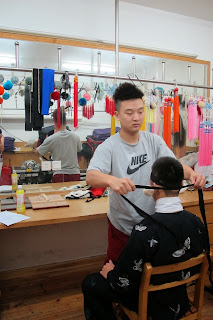This month I took the opportunity to participate in a tour of the Shanghai Opera School.
The Shanghai Opera School is one of the top 2 opera schools in China (the other being based in Beijing) . They take students in from the age of 5 and they are schooled up until the time they attend college - when they hope to graduate and earn entry into the College of Arts. Only 50% of the students will succeed and enter the College of Arts.
We attended on a regular school day, so the students were all busy with their classes.
The tour was organised by the Shanghai Expatriate Association and lead by Mr Zhao, a well known playwright and an early student of the school.
We started our tour with a sneak peak into the make up room where the performers were preparing themselves for the afternoon performance.

 |
| It can take up to 2 hours to prepare one's makeup |
After makeup it was on to wardrobe to view the costumes up close.
 |
| Outer garment warn by concubine |
 |
| Embroided detail on costume |
Classic Chinese opera dates back to the 3rd century. Unlike western opera, each performer must become proficient not only in voice but must also master acrobatics, dancing, drama and instrumentation.
The students must learn all of the components of opera and complete standard schooling.
 |
| Acrobatics training |

After an hour of watching the students undertake their acrobatics training it was back to the dressing room to watch the students dress for their performance
Given that the facial expressions and facial art work form such an important role in the opera the performers are required to have their faces pulled back and held taut by a excruciatingly tight head band.
The costumes and head pieces the performers wear are extremely heavy and are worn layer upon layer. Apparently they are overwhelmingly hot.
So it would seem that regardless of the art - there always seems to be a hidden agony behind the beauty!
But the show must go on!
The first performance the students treat us to is a mimed performance accompanied only by the string and drum orchestra. It is humorous and very much like a 3 stooges performances where exaggerated moves and facial expressions portray much of the story!
There is a great deal of acrobatics and a phenomenal choreographed fight scene.
 |
| The Hero |
 |
| The clown |
 |
| The duel |
The second performance is more like a play where the spoken word is used. It too is accompanied by the string and drum orchestra and involves dance and acrobatics.
Despite the school being well attended by many a dedicated student Mr Zhao tells us that this form of performing art is becoming a less and less popular pursuit for talented youth as they see more opportunity for fame and fortune in the pop industry.
It was indeed a rare treat to slip behind the scenes of an everyday school of the arts and gain an insight into what it takes to become a performer of the Chinese opera and to learn and experience yet another element of China's fascinating culture and tradition.

























































